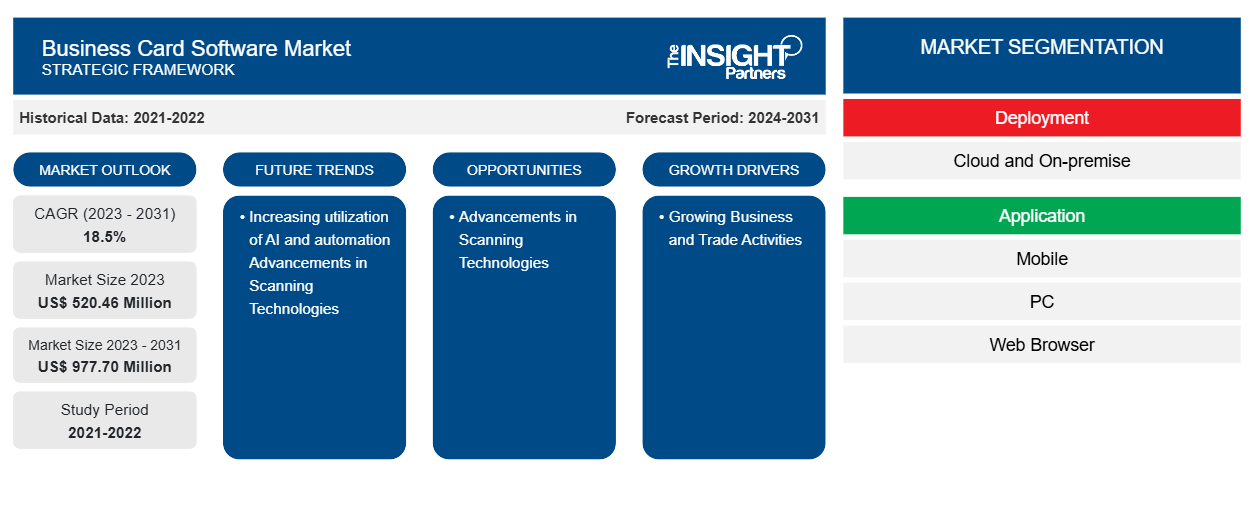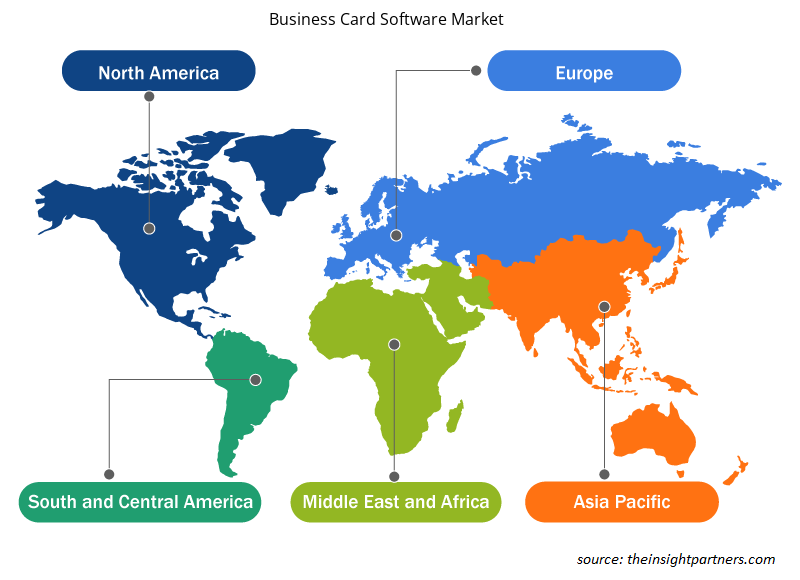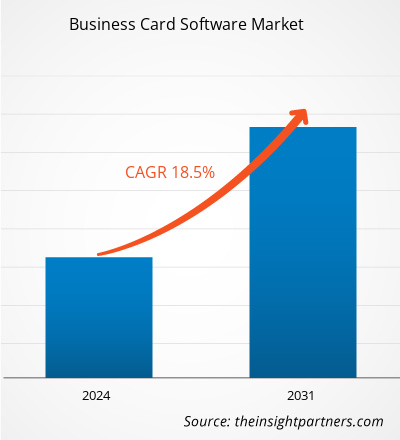The global business card software market size is expected to grow from US$ 520.46 million in 2023 to US$ 977.70 million by 2031; it is anticipated to expand at a CAGR of 18.5% from 2023 to 2031. The increasing utilization of AI and automation is likely to remain a key business card software market trends.
Business Card Software Market Analysis
The introduction of improved smart scanning technologies has increased the demand for business card scanning management software. Consumers are moving away from traditional paper business cards and toward digital alternatives, which is driving revenue development in this market sector.
Business Card Software Market Overview
Business card software is a powerful tool that transforms how professionals maintain their contact information. Designed with the present business environment in mind, this program simplifies the process of designing, organizing, and exchanging business cards, improving networking skills and encouraging brand consistency. Business Card Software allows professionals to effortlessly design and personalize their own business cards. The program provides a variety of templates and design possibilities, enabling users to build visually appealing and professional-looking cards that suit their corporate identity. Whether it's choosing fonts, colors, or logos, the program has a simple interface that allows users to easily design unique business cards that leave a memorable impression.
Customize This Report To Suit Your Requirement
You will get customization on any report - free of charge - including parts of this report, or country-level analysis, Excel Data pack, as well as avail great offers and discounts for start-ups & universities
Business Card Software Market: Strategic Insights

- Get Top Key Market Trends of this report.This FREE sample will include data analysis, ranging from market trends to estimates and forecasts.
You will get customization on any report - free of charge - including parts of this report, or country-level analysis, Excel Data pack, as well as avail great offers and discounts for start-ups & universities
Business Card Software Market: Strategic Insights

- Get Top Key Market Trends of this report.This FREE sample will include data analysis, ranging from market trends to estimates and forecasts.
Business Card Software Market Drivers and Opportunities
Growing Business and Trade Activities to Favor Market
Business card software sales are predicted to skyrocket as global business and trade operations expand. This expansion is especially noticeable in places such as North America, Europe, and APAC, which have technologically sophisticated economies and a significant need for business card software. Furthermore, market globalization and technological advancements have contributed significantly to the expansion of commercial and trade activity. Technology has proletarianized communication, transportation, and travel, making remote areas and destitute people want modernity's attraction. This has led to an increasing demand for business card software as companies seek to customize their products for the demands of new markets.
Advancements in Scanning Technologies
The emergence of advanced smart scanning technologies has indeed fuelled the demand for business card scanning management software. This shift is driven by consumers transitioning from traditional paper business cards to digital equivalents, which has led to the growth of the market segment for business card scanning applications. Business card scanning applications are used by businesses to scan business cards using a smartphone camera. These applications utilize optical character recognition (OCR) technology to automatically extract and store the information from the card into the user's phone. The scanned cards are then transformed into digital contacts stored in a virtual address book, allowing for easy management and organization.
Business Card Software Market Report Segmentation Analysis
Key segments that contributed to the derivation of the business card software market analysis deployment and application.
- Based on deployment, the market is divided into on-premises and cloud. The cloud segment held a larger market share in 2023.
- Based on application, the market is bifurcated into mobile, PC, and web browser. The web browser segment held a larger market share in 2023.
Business Card Software Market Share Analysis by Geography
The geographic scope of the business card software market report is mainly divided into five regions: North America, Asia Pacific, Europe, Middle East & Africa, and South America/South & Central America. North America dominated the business card software market in 2023. The market for business card software in North America is experiencing significant growth due to the increasing digitization of business processes. Professionals are adopting digital networking and contact management solutions to streamline their operations. The widespread use of smartphones and mobile devices has further fuelled the demand for mobile-friendly business card apps. Additionally, businesses require seamless integration of this software with other tools, such as CRM software, to enhance efficiency in networking and data organization. As a result, there is a growing need for advanced and user-friendly business card software in the North American market.
Business Card Software Market Regional Insights
The regional trends and factors influencing the Business Card Software Market throughout the forecast period have been thoroughly explained by the analysts at Insight Partners. This section also discusses Business Card Software Market segments and geography across North America, Europe, Asia Pacific, Middle East and Africa, and South and Central America.

- Get the Regional Specific Data for Business Card Software Market
Business Card Software Market Report Scope
| Report Attribute | Details |
|---|---|
| Market size in 2023 | US$ 520.46 Million |
| Market Size by 2031 | US$ 977.70 Million |
| Global CAGR (2023 - 2031) | 18.5% |
| Historical Data | 2021-2022 |
| Forecast period | 2024-2031 |
| Segments Covered |
By Deployment
|
| Regions and Countries Covered | North America
|
| Market leaders and key company profiles |
Business Card Software Market Players Density: Understanding Its Impact on Business Dynamics
The Business Card Software Market is growing rapidly, driven by increasing end-user demand due to factors such as evolving consumer preferences, technological advancements, and greater awareness of the product's benefits. As demand rises, businesses are expanding their offerings, innovating to meet consumer needs, and capitalizing on emerging trends, which further fuels market growth.
Market players density refers to the distribution of firms or companies operating within a particular market or industry. It indicates how many competitors (market players) are present in a given market space relative to its size or total market value.
Major Companies operating in the Business Card Software Market are:
- ABBY
- Adobe
- Mojosoft
- CAM Development
- DRPU SOFTWARE PVT. LTD
- Haystack
Disclaimer: The companies listed above are not ranked in any particular order.

- Get the Business Card Software Market top key players overview
Business Card Software Market News and Recent Developments
The business card software market is evaluated by gathering qualitative and quantitative data post primary and secondary research, which includes important corporate publications, association data, and databases. The following is a list of developments in the market:
- In August 2022, Adobe announced improvements to its Adobe Cloud Document, including enhancements to Adobe Scan, Adobe Sign, and integration with Microsoft 365. This integration enables users to create, manipulate, and view high-quality, secure PDFs directly within Microsoft 365 applications.
(Source: Adobe, Press Release, 2022)
Business Card Software Market Report Coverage and Deliverables
The "Business Card Software Market Size and Forecast (2021–2031)" report provides a detailed analysis of the market covering below areas:
- Market size and forecast at global, regional, and country levels for all the key market segments covered under the scope
- Market dynamics such as drivers, restraints, and key opportunities
- Key future trends
- Detailed PEST/Porter's Five Forces and SWOT analysis
- Global and regional market analysis covering key market trends, major players, regulations, and recent market developments
- Industry landscape and competition analysis covering market concentration, heat map analysis, prominent players, and recent developments
- Detailed company profiles
Frequently Asked Questions
What will be the market size of the global business card software market by 2031?
The global business card software market is expected to reach US$ 977.70 million by 2031.
Which are the key players holding the major market share of the global business card software market?
The key players holding the majority of shares in global business card software are ABBY, Adobe, Mojosoft, CAM Development, and DRPU SOFTWARE PVT. LTD.
What are the future trends of the global business card software market?
The increasing utilization of AI and automation is likely to remain a key business card software market trends.
What are the driving factors impacting the global business card software market?
The emergence of advanced smart scanning technologies has fuelled the demand for business card software management software.
What is the estimated market size for the global business card software market in 2023?
The business card software market size is expected to grow from US$ 520.46 million in 2023 to US$ 977.70 million by 2031; it is anticipated to expand at a CAGR of 8.2% from 2024 to 2031.
- Historical Analysis (2 Years), Base Year, Forecast (7 Years) with CAGR
- PEST and SWOT Analysis
- Market Size Value / Volume - Global, Regional, Country
- Industry and Competitive Landscape
- Excel Dataset
- Parking Meter Apps Market
- eSIM Market
- Advanced Distributed Management System Market
- Online Exam Proctoring Market
- Electronic Data Interchange Market
- Barcode Software Market
- Maritime Analytics Market
- Cloud Manufacturing Execution System (MES) Market
- Robotic Process Automation Market
- Digital Signature Market
Testimonials
I wish to appreciate your support and the professionalism you displayed in the course of attending to my request for information regarding to infectious disease IVD market in Nigeria. I appreciate your patience, your guidance, and the fact that you were willing to offer a discount, which eventually made it possible for us to close a deal. I look forward to engaging The Insight Partners in the future, all thanks to the impression you have created in me as a result of this first encounter.
DR CHIJIOKE ONYIA, MANAGING DIRECTOR, PineCrest Healthcare Ltd.The Insight Partners delivered insightful, well-structured market research with strong domain expertise. Their team was professional and responsive throughout. The user-friendly website made accessing industry reports seamless. We highly recommend them for reliable, high-quality research services
Yukihiko Adachi CEO, Deep Blue, LLC.Reason to Buy
- Informed Decision-Making
- Understanding Market Dynamics
- Competitive Analysis
- Customer Insights
- Market Forecasts
- Risk Mitigation
- Strategic Planning
- Investment Justification
- Identifying Emerging Markets
- Enhancing Marketing Strategies
- Boosting Operational Efficiency
- Tracking Industry Innovations
- Aligning with Regulatory Trends
Yes! We provide a free sample of the report, which includes Report Scope (Table of Contents), report structure, and selected insights to help you assess the value of the full report. Please click on the "Download Sample" button or contact us to receive your copy.
Absolutely — analyst assistance is part of the package. You can connect with our analyst post-purchase to clarify report insights, methodology or discuss how the findings apply to your business needs.
Once your order is successfully placed, you will receive a confirmation email along with your invoice.
• For published reports: You’ll receive access to the report within 4–6 working hours via a secured email sent to your email.
• For upcoming reports: Your order will be recorded as a pre-booking. Our team will share the estimated release date and keep you informed of any updates. As soon as the report is published, it will be delivered to your registered email.
We offer customization options to align the report with your specific objectives. Whether you need deeper insights into a particular region, industry segment, competitor analysis, or data cut, our research team can tailor the report accordingly. Please share your requirements with us, and we’ll be happy to provide a customized proposal or scope.
The report is available in either PDF format or as an Excel dataset, depending on the license you choose.
The PDF version provides the full analysis and visuals in a ready-to-read format. The Excel dataset includes all underlying data tables for easy manipulation and further analysis.
Please review the license options at checkout or contact us to confirm which formats are included with your purchase.
Our payment process is fully secure and PCI-DSS compliant.
We use trusted and encrypted payment gateways to ensure that all transactions are protected with industry-standard SSL encryption. Your payment details are never stored on our servers and are handled securely by certified third-party processors.
You can make your purchase with confidence, knowing your personal and financial information is safe with us.
Yes, we do offer special pricing for bulk purchases.
If you're interested in purchasing multiple reports, we’re happy to provide a customized bundle offer or volume-based discount tailored to your needs. Please contact our sales team with the list of reports you’re considering, and we’ll share a personalized quote.
Yes, absolutely.
Our team is available to help you make an informed decision. Whether you have questions about the report’s scope, methodology, customization options, or which license suits you best, we’re here to assist. Please reach out to us at sales@theinsightpartners.com, and one of our representatives will get in touch promptly.
Yes, a billing invoice will be automatically generated and sent to your registered email upon successful completion of your purchase.
If you need the invoice in a specific format or require additional details (such as company name, GST, or VAT information), feel free to contact us, and we’ll be happy to assist.
Yes, certainly.
If you encounter any difficulties accessing or receiving your report, our support team is ready to assist you. Simply reach out to us via email or live chat with your order information, and we’ll ensure the issue is resolved quickly so you can access your report without interruption.





















 Get Free Sample For
Get Free Sample For